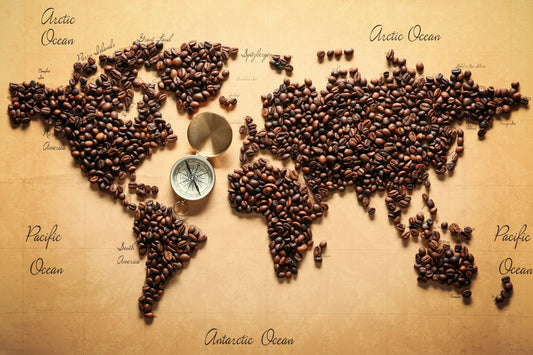There is a fascinating history behind the origins of coffee. For centuries, the bean has been transported around the world, smuggled out of certain countries, stolen from royalty, and has shaped entire nations and economies. It's amazing how a bean from a tiny tree in Ethiopia became the world's 2nd most traded commodity.
What is the origin of coffee? It's easy to answer this question. It originated in Ethiopia in the old days. But how did the bean make its way around the world? This is what we will explore.
An Ethiopian Legend
There are many stories of the discovery of the very first coffee bean and its extraordinarily stimulating effect. Kaldi, an Ethiopian goat herder of the 9th century, proved to be the first to discover coffee, according to an Ethiopian story written down in 1671. He observed that his goats were acting strangely when eating the fruits of a mid-sized, dark green shrubbery with yellow and red berries while roaming the country of Ethiopian kingdom, Kaffa.
His curiosity led him to take some of those stimulating "magic berries" to the next monastery so the chaplain could explain the effects to him. Furiously tossing the berries into the fire, the chaplain declared it a devilish temptation. As soon as the roasted coffee was lit, the monks were enchanted by its unique and aromatic scent. After saving the beans from the fire, they made the first cup of coffee sooner or later.
The Arabian Peninsula
As word spread eastward and coffee reached the Arabian Peninsula, it began a journey that would take these beans around the world.
In addition to some myths surrounding the origin of coffee, Yemen also has a well-founded claim to the beverage's actual history. By comparison with the Kaldi myth, the Yemeni legend is rather basic. Yemenite Sufi mystic Ghothul Akbar Nooruddin Abu al-Hasan al-Shadhili was traveling through Ethiopia, presumably on spiritual matters, when he came across some very energetic birds which had been eating fruit from the bunn plant, also known as the coffee plant in other parts of the world. He was exhausted after his journey, so he decided to try the berries for himself and discovered that they produced an energetic feeling in him as well.
A second story revolves around Sheikh Omar, a priest and doctor exiled to a desert cave near Ousab by Sheik Abou'l Hasan Schadheli from Mocha, Yemen, where he was a follower of Sheikh Abou'l Hasan Schadheli. The legend states that after being exiled for some time and on the verge of starvation, Omar found the red berries of coffee plants and tried to consume them. Another story claims a bird brought him coffee cherries after he begged for guidance from his master.
Omar found the berries too bitter to eat raw. To eliminate the bitterness, he roasted the berries. This basic "roasting" method hardened the berries, making them unusable for chewing. Omar then tried to soften the berries by boiling them in water.
Having observed the pleasant aroma of the increasingly brown liquid as the berries boiled, he decided to drink the decoction rather than eat the beans. He found the drink to be refreshing and shared his account with others.
The new world
In the 17th century, almost all coffee was sourced from the Yemen province in southern Arabia. However, with the growing popularity of the beverage, the coffee plant spread rapidly to Java. Coffee was exported to other islands of the Indonesian archipelago in the 17th century and the Americas in the 18th century. Coffee cultivation was first introduced to the Hawaiian Islands in 1825.
The coffee industry became the world's most valuable export crop by the end of the 18th century. Following crude oil, it is the world's most sought-after commodity these days.



